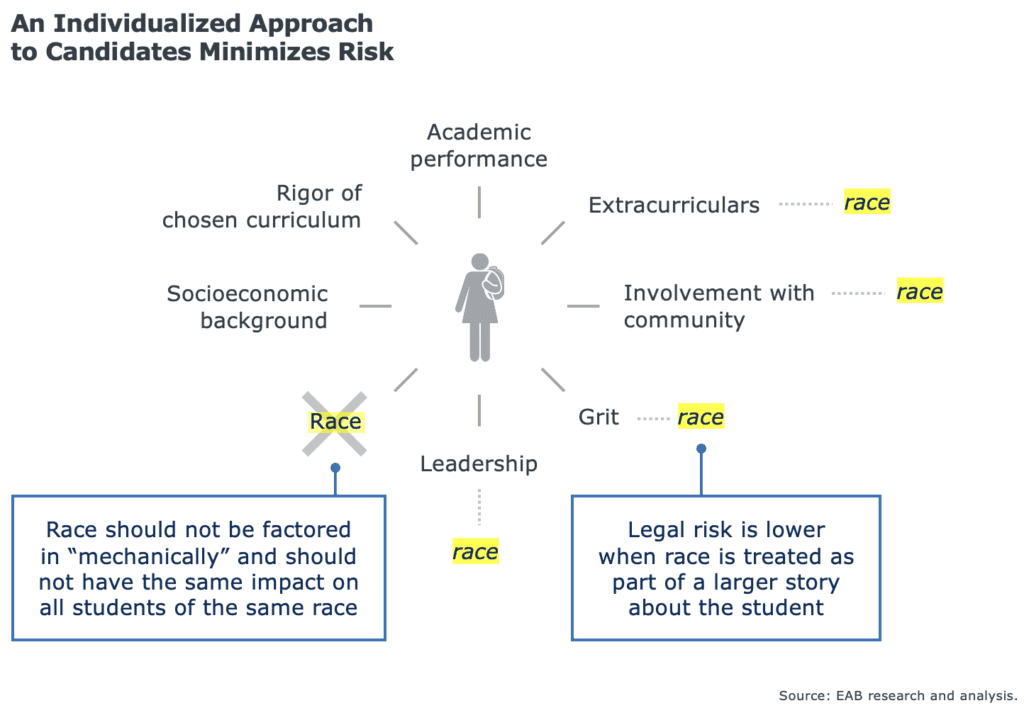Key takeaways from government guidance on SCOTUS’s affirmative action ruling
The Department of Education finally issued its eagerly anticipated follow-up guidance on the Supreme Court’s SFFA ruling in September. Did it deliver on enrollment leaders’ hopes and expectations? The answer is complicated.
While higher education leaders found plenty to be appalled about in the SCOTUS opinion, one of the most troubling aspects of it was its lack of clarity on core practical questions related to the consideration of race in student recruitment. As Liam Knox of Inside Higher Ed put it, the ruling was “a vague and at times self-contradictory piece of jurisprudence that continues to frustrate colleges keen to maintain diversity without falling out of compliance.”
Emblematic of this ambiguity was the Court’s simultaneous assertion that, on the one hand, nothing in the opinion “should be construed as prohibiting universities from considering an applicant’s discussion of how race affected his or her life, be it through discrimination, inspiration, or otherwise,” while, on the other, “…universities may not simply establish through application essays or other means the regime we hold unlawful today.” What does this mean, exactly? Nobody is quite sure, and many are, as a result, concerned that whatever use they do make of race in their admissions processes may put them on the wrong side of the law.

Guidance from the Department of Education
Resolving concerns such as those just mentioned was a key aim of subsequent guidance issued by the Department of Education—information that came in the form of a seven-page memo released on August 14 and a 60+ page report released in September. Both pieces are essential reading for enrollment leaders.
The memo provides a helpful high-level summary of the key issues, answering such questions as what the Supreme Court decided, whether and how colleges and universities may consider students’ race in admissions decisions, and what steps, generally speaking, schools can take to achieve a diverse student body. In other words, this document provides a quick refresher on the essential issues involved in post-SCOTUS diversity strategy.
The 60+ page report, titled “Strategies for Increasing Diversity and Opportunity in Higher Education,” offers a more in-depth look at approaches referenced in the memo. That includes illustrating them with specific examples of school- and state-sponsored initiatives, tying them back to specific points from the Court’s ruling, and offering helpful context on related issues, including key stats on racial equity in higher education and thoughtfully articulated arguments in favor of enrolling a more diverse student body. Specific approaches on which it gives detailed guidance include:
Approaches to adopt or expand:
- targeted outreach and pathways programs
- dual-enrollment and early-college programs
- summer programs
- K-12 college counseling
- community-college partnerships
- direct-admission programs
- top-percent plans
Approaches to phase out or limit:
- legacy preferences
- heavy reliance on standardized testing
- early-application programs
- restrictive prerequisite requirements
Particularly helpful is the advice the piece offers on holistic applicant review emphasizing adversity, resilience, and inspiration, including qualitative measures that may be used to assess students’ contributions and how to train admissions reviewers on the assessment of these qualities in applicants.

Looking beyond the guidance offered by the Department, enrollment leaders should keep in view the large body of research on legally sound approaches to recruiting underrepresented students that predates the SCOTUS decision, much of which still applies. A prime example is the College Board and Education Counsel publication “The Playbook: Understanding the Role of Race Neutral Strategies in Advancing Higher Education Diversity Goals.”
Unanswered questions on race-based financial aid
The follow-up guidance from the Department of Education does, however, leave key questions unanswered—for example, whether it’s legally OK to award institutional financial aid based on race or ethnicity.
To give some sense of the level of confusion on this point, in a poll we did at July’s ACT national meeting (after the Court’s ruling was released), a little over a third of respondents said they thought it was OK, a little over a third thought it was not, and a little less than a third were not sure.
Since the Court’s ruling did not specifically address financial aid, some have assumed that it is exempt. It would be more accurate to say that the ruling puts us in uncharted—and very risky—territory where race-based aid awarding is concerned. Since the Court’s ruling invalidated the “compelling interest” standard that, until recently, was the legal basis for affirmative action in admissions decisions, there’s currently no existing court-recognized precedent that schools can rely on to justify race-based financial aid. As Art Coleman, a leading expert on laws governing affirmative action in higher education has argued, “you can’t just say that the Court’s ruling has nothing to do with financial aid and scholarships. It has everything to do with any kind of policy and practice that would have a race-status consideration for which you would need some compelling interest.”
While new compelling-interest standards of the sort that would allow schools to consider applicants’ race, per se, in admit and aid decisions may eventually be established, for the time being such approaches are, effectively, off the table.
Legally sound diversity strategy is institution-specific and grounded in purpose
Another (unavoidable) shortcoming of the guidance issued by the Department of Education is that it cannot offer definitive advice with respect to the suitability of particular practices for any given college or university, since highly local factors ultimately determine the legal soundness and effectiveness of any given race-aware admissions policy. A practice that may work exceptionally well for one institution could spell trouble for another, given differences in their geographic location, their service area, or their precise mission.
For this reason, enrollment leaders should develop their diversity-focused initiatives in partnership with legal experts.
One test your legal advisors will likely apply to any approach you’re considering will be the extent to which it is consistent with clearly stated objectives of your college or university, including those enshrined in its mission. Is promoting social mobility one of your institution’s primary goals? If so, admissions practices that favor first-generation and low-income college goers—which will also, incidentally, tend to favor students from underrepresented racial and ethnic groups—may make it easier to defend against accusations that your admissions practices are illegally tipping the scales in favor of black and brown students.
This last point is also the reason that discussions regarding your diversity strategy should involve the seniormost leaders in your organization. It is ultimately your school’s mission that will provide the surest insulation against legal perils associated with diversity strategy, and such policy cannot be shaped and endorsed without the direct involvement of your cabinet.
Several points discussed in this piece are expanded upon in greater detail By Art Coleman in this EAB Office Hours podcast episode.
More Blogs

What enrollment leaders can learn from Alabama’s statewide direct admissions program

Is your yield rate okay?
